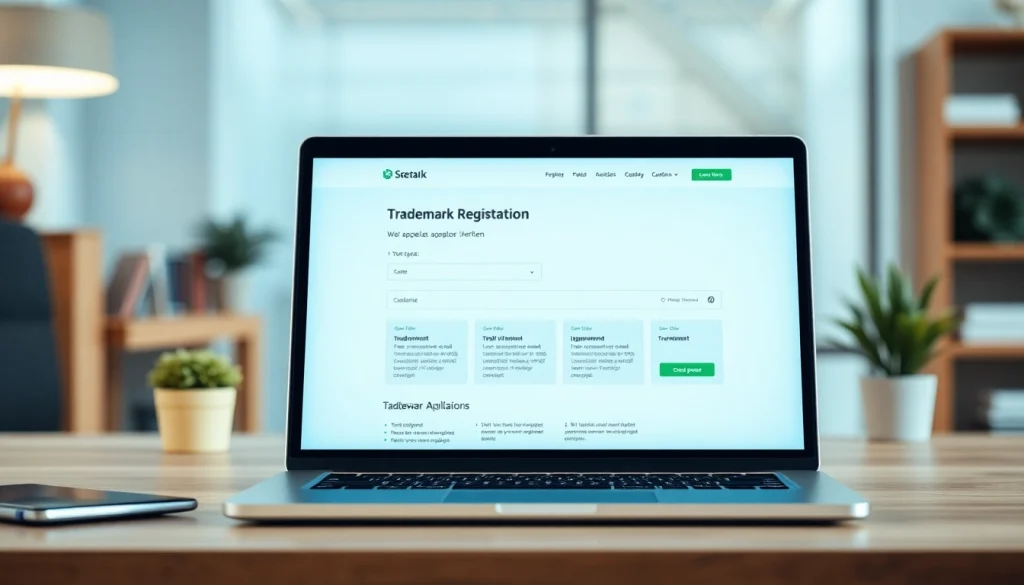
Understanding the Importance of Trademark Registration
In today’s competitive marketplace, your brand identity is undoubtedly one of the most valuable assets your business possesses. One of the key components of establishing and protecting that identity is online trademark registration platform. Registering a trademark isn’t just about having legal ownership of your brand; it’s a significant move towards ensuring the uniqueness and integrity of your business identity.
Why Register a Trademark?
Trademark registration is essential for various reasons. First and foremost, it confers legal rights that allow you to exclusively use a brand name or logo in your particular industry. A registered trademark acts as a shield against potential legal issues, such as brand infringement and counterfeiting. In addition:
- Legal Protection: A trademark provides the legal foundation to enforce your rights against infringers.
- Brand Loyalty: A well-registered trademark can build brand recognition and customer loyalty.
- Asset Value: Trademarks can be valuable business assets that can be sold or licensed, creating additional revenue streams.
- Global Reach: Registering your trademark can strengthen your brand in international markets, enhancing your credibility.
Elements of a Trademark
To effectively understand trademarks, it’s crucial to know their key elements. Essentially, a trademark can be any distinctive sign capable of identifying the goods or services of a particular source. The main categories include:
- Name: This could be a business name, product name, or a service name.
- Logo: A unique design that symbolizes your brand.
- Slogan: A phrase that represents your business ethos or offerings.
- Sound and Smell: Some brands protect sounds or scents that are unique to them.
Common Myths About Trademarks
Despite the clear benefits of trademark registration, there are many misconceptions surrounding the process. These include:
- Myth 1: “I don’t need to register my trademark; I have been using it.” While usage establishes some rights, registration provides stronger legal protection.
- Myth 2: “A business name is automatically a trademark.” Not all business names qualify as trademarks; they must be distinctive.
- Myth 3: “Trademarks are only for big companies.” In truth, trademarks are essential for businesses of all sizes to protect their brand identity.
Navigating the Online Trademark Registration Platform
With the rise of digital technology, online trademark registration platforms have simplified the trademark process. However, navigating these platforms effectively requires an understanding of key features and steps involved in the application process.
Getting Started: Key Features to Look For
When selecting an online trademark registration platform, consider these essential features:
- User-Friendly Interface: A simple, intuitive design to help first-time users navigate the platform easily.
- Comprehensive Inventory: The ability to conduct trademark searches to ensure your desired name or logo isn’t already taken.
- Guidance and Resources: Availability of educational materials and legal guidance throughout the registration process.
- Tracking and Management Tools: Features to help you manage your trademark portfolio after registration.
Step-by-Step Application Process
The application process for trademark registration typically follows these steps:
- Conduct a Search: Start by conducting a comprehensive search to check the availability of your trademark.
- Choose Your Trademark Class: Identify the appropriate class for your business services or goods.
- Prepare Your Application: Fill out the application form accurately and provide the necessary details.
- Submit Your Application: Submit your application online and pay the required fee.
- Monitor the Application: Regularly check the status of your application for updates.
Integrating Trademark Searches on the Platform
Integrating thorough trademark searches into your application process is crucial. A good online trademark registration platform allows users to:
- Access Comprehensive Databases: Utilize databases that include existing trademarks to assess the risk of conflicts.
- Keyword Searches: Use keywords relevant to your brand to find similar trademarks.
- View Similar Mark Registrations: Understand the competition and possible issues with similar marks in the market.
Benefits of Using an Online Service
Online trademark registration platforms provide numerous advantages that traditional methods may lack.
Cost Efficiency Compared to Traditional Methods
The costs associated with trademark registration can vary considerably. However, utilizing an online service often proves more cost-effective due to:
- Lower Fees: Online platforms generally have reduced administrative costs and can pass those savings onto users.
- Time Savings: Rapid application processes compared to the traditional court or office visits.
- Transparent Pricing: Many online platforms offer clear pricing structures without hidden fees.
Access to Expert Guidance and Resources
Most online platforms have curated resources and expert guidance, allowing applicants to:
- Understand the Registration Process: Step-by-step resources guide users through the intricacies of trademark laws.
- Consult with Experts: Accessibility to legal professionals for consultations and clarifications.
- Tools for Self-Help: Online tools to help applicants prepare their applications or conduct initial searches.
User Testimonials and Success Stories
Real-world experiences can offer insights into the effectiveness of an online trademark registration platform:
- Case Studies: Review case studies that demonstrate successful trademark registrations.
- User Feedback: Analyze testimonials that provide insights on user satisfaction and the ease of the application process.
Common Challenges and How to Overcome Them
While the trademark registration process with an online platform is simplified, applicants may encounter various challenges. Understanding these and knowing how to mitigate them can lead to a smoother registration experience.
Handling Rejections and Objections in Applications
Even a well-prepared application may face rejections. Here is how to handle them effectively:
- Understanding the Reasons: Assess the objections listed by the trademark office meticulously.
- Resubmission: Make necessary changes based on the feedback and resubmit your application promptly.
- Professional Assistance: Seek legal help if needed, especially for complex objections.
Frequently Asked Questions About Application Process
Many applicants have similar questions. Here are some common queries:
- How long does the registration process take? The processing time can range from a few months to over a year, depending on the complexity of your application.
- What happens if someone infringes on my trademark? You have the legal right to enforce your trademark and take action against infringers.
- Can trademarks expire? Yes, trademarks require renewal periodically, typically every 10 years in the U.S.
Tips for Choosing the Right Trademark Class
Selecting the appropriate class for trademark registration is vital for ensuring protection. Here are some tips:
- Research Classes: Familiarize yourself with the various classes available and which products or services fall under them.
- Consider Future Growth: If you plan to expand your offerings, choose classes that cover those potential products or services.
- Consult Resources: Utilize the classification guides provided by trademark offices.
Monitoring and Maintaining Your Trademark
Once you’ve successfully registered your trademark, the journey isn’t over. Ongoing monitoring and maintenance are crucial to safeguarding your brand.
Keeping Track of Renewals and Deadlines
Trademark registrations require regular renewals, and failure to track them can lead to loss of rights. To manage this:
- Create a Schedule: Set reminders for renewal deadlines and any other important dates related to your trademark.
- Use Online Tools: Many platforms offer tools for monitoring deadlines and tracking trademark status.
- Stay Informed: Keep up to date with any changes in trademark laws or processes that may affect your registration.
Using Online Tools for Trademark Monitoring
Employing online tools enhances the management of your trademark portfolio. These tools can assist in:
- Monitoring Competitors: Keeping tabs on new trademarks in your industry to catch any potential conflicts early.
- Trademark Watch Services: Enabling alerts for any filings or uses that may infringe upon your rights.
- Analytics Tools: Providing insights about the market and your trademark standing in relation to competitors.
Building Brand Protection Strategies
Lastly, it’s essential to build comprehensive brand protection strategies. These strategies should include:
- Regular Audits: Periodically review your trademarks to assess their value and strategic alignment with your business goals.
- Enforcement of Rights: Be proactive in addressing any infringements you become aware of.
- Public Awareness: Educate your customers about your trademark to reinforce your brand identity.






